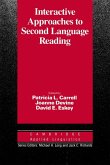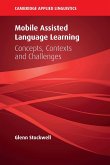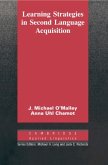William Grabe (Northern Arizona University), Junko Yamashita (Japan Nagoya University)
Reading in a Second Language
William Grabe (Northern Arizona University), Junko Yamashita (Japan Nagoya University)
Reading in a Second Language
- Broschiertes Buch
- Merkliste
- Auf die Merkliste
- Bewerten Bewerten
- Teilen
- Produkt teilen
- Produkterinnerung
- Produkterinnerung
Now in its second edition, this book provides a comprehensive overview of research into reading, and how this can be applied in practice, in both L1 and L2 settings. This new edition has been thoroughly updated, making it essential reading for anyone who wants to grasp how reading works.
Andere Kunden interessierten sich auch für
![Interactive Approaches to Second Language Reading Interactive Approaches to Second Language Reading]() Interactive Approaches to Second Language Reading65,99 €
Interactive Approaches to Second Language Reading65,99 €![Task-Based Language Teaching Task-Based Language Teaching]() Rod Ellis (University of Auckland)Task-Based Language Teaching45,99 €
Rod Ellis (University of Auckland)Task-Based Language Teaching45,99 €![Mobile Assisted Language Learning Mobile Assisted Language Learning]() Glenn Stockwell (Japan Waseda University)Mobile Assisted Language Learning42,99 €
Glenn Stockwell (Japan Waseda University)Mobile Assisted Language Learning42,99 €![Learning Strategies in Second Language Acquisition Learning Strategies in Second Language Acquisition]() J. Michael O'MalleyLearning Strategies in Second Language Acquisition64,99 €
J. Michael O'MalleyLearning Strategies in Second Language Acquisition64,99 €![The Language of Mental Illness The Language of Mental Illness]() Hazel Price (University of Salford)The Language of Mental Illness40,99 €
Hazel Price (University of Salford)The Language of Mental Illness40,99 €![Validity Argument in Language Testing Validity Argument in Language Testing]() Validity Argument in Language Testing52,99 €
Validity Argument in Language Testing52,99 €![Researching English Medium Instruction Researching English Medium Instruction]() Researching English Medium Instruction38,99 €
Researching English Medium Instruction38,99 €-
-
-
Now in its second edition, this book provides a comprehensive overview of research into reading, and how this can be applied in practice, in both L1 and L2 settings. This new edition has been thoroughly updated, making it essential reading for anyone who wants to grasp how reading works.
Produktdetails
- Produktdetails
- Cambridge Applied Linguistics
- Verlag: Cambridge University Press
- 2 Revised edition
- Seitenzahl: 604
- Erscheinungstermin: 18. August 2022
- Englisch
- Abmessung: 229mm x 152mm x 33mm
- Gewicht: 876g
- ISBN-13: 9781108793704
- ISBN-10: 1108793703
- Artikelnr.: 63509513
- Herstellerkennzeichnung
- Libri GmbH
- Europaallee 1
- 36244 Bad Hersfeld
- gpsr@libri.de
- Cambridge Applied Linguistics
- Verlag: Cambridge University Press
- 2 Revised edition
- Seitenzahl: 604
- Erscheinungstermin: 18. August 2022
- Englisch
- Abmessung: 229mm x 152mm x 33mm
- Gewicht: 876g
- ISBN-13: 9781108793704
- ISBN-10: 1108793703
- Artikelnr.: 63509513
- Herstellerkennzeichnung
- Libri GmbH
- Europaallee 1
- 36244 Bad Hersfeld
- gpsr@libri.de
William Grabe is Emeritus Regents Professor of Applied Linguistics at Northern Arizona University (NAU). He has been exploring research on reading comprehension, reading development, and reading instruction for over 40 years. He was President of AAAL from 2001-2002, and Vice President for Research at NAU from 2012-2017.
Preface
Part I. Foundations of Reading: 1. The nature of reading: Defining reading
2. How reading works: Building blocks of fluency and comprehension
3. How reading works: comprehension processes
4. Cognitive issues in reading
5. Neurocognitive processes and reading ability
6. Explaining reading comprehension: Models of reading
Part II. Patterns of Variation in Reading: 7. Reading in different languages
8. L1 and L2 reading relationships
9. Social contexts of reading
10. Motivation for reading
Part III. Developing Reading Comprehension Abilities: 11. Vocabulary and reading comprehension
12. Building main idea comprehension: syntax and strategies
13. Becoming a strategic reader
14. Building awareness of discourse structure
Part IV. Expanding Reading Comprehension Skills: 15. Reading to learn and reading/writing relationships
16. Reading in digital contexts
17. Reading fluency, reading rate, and comprehension
18. Extensive reading
Part V. Applications of Reading Research: Instruction and Assessment
19. Reading curriculum and instruction
20. Reading assessment
References
Indexes.
Part I. Foundations of Reading: 1. The nature of reading: Defining reading
2. How reading works: Building blocks of fluency and comprehension
3. How reading works: comprehension processes
4. Cognitive issues in reading
5. Neurocognitive processes and reading ability
6. Explaining reading comprehension: Models of reading
Part II. Patterns of Variation in Reading: 7. Reading in different languages
8. L1 and L2 reading relationships
9. Social contexts of reading
10. Motivation for reading
Part III. Developing Reading Comprehension Abilities: 11. Vocabulary and reading comprehension
12. Building main idea comprehension: syntax and strategies
13. Becoming a strategic reader
14. Building awareness of discourse structure
Part IV. Expanding Reading Comprehension Skills: 15. Reading to learn and reading/writing relationships
16. Reading in digital contexts
17. Reading fluency, reading rate, and comprehension
18. Extensive reading
Part V. Applications of Reading Research: Instruction and Assessment
19. Reading curriculum and instruction
20. Reading assessment
References
Indexes.
Preface
Part I. Foundations of Reading: 1. The nature of reading: Defining reading
2. How reading works: Building blocks of fluency and comprehension
3. How reading works: comprehension processes
4. Cognitive issues in reading
5. Neurocognitive processes and reading ability
6. Explaining reading comprehension: Models of reading
Part II. Patterns of Variation in Reading: 7. Reading in different languages
8. L1 and L2 reading relationships
9. Social contexts of reading
10. Motivation for reading
Part III. Developing Reading Comprehension Abilities: 11. Vocabulary and reading comprehension
12. Building main idea comprehension: syntax and strategies
13. Becoming a strategic reader
14. Building awareness of discourse structure
Part IV. Expanding Reading Comprehension Skills: 15. Reading to learn and reading/writing relationships
16. Reading in digital contexts
17. Reading fluency, reading rate, and comprehension
18. Extensive reading
Part V. Applications of Reading Research: Instruction and Assessment
19. Reading curriculum and instruction
20. Reading assessment
References
Indexes.
Part I. Foundations of Reading: 1. The nature of reading: Defining reading
2. How reading works: Building blocks of fluency and comprehension
3. How reading works: comprehension processes
4. Cognitive issues in reading
5. Neurocognitive processes and reading ability
6. Explaining reading comprehension: Models of reading
Part II. Patterns of Variation in Reading: 7. Reading in different languages
8. L1 and L2 reading relationships
9. Social contexts of reading
10. Motivation for reading
Part III. Developing Reading Comprehension Abilities: 11. Vocabulary and reading comprehension
12. Building main idea comprehension: syntax and strategies
13. Becoming a strategic reader
14. Building awareness of discourse structure
Part IV. Expanding Reading Comprehension Skills: 15. Reading to learn and reading/writing relationships
16. Reading in digital contexts
17. Reading fluency, reading rate, and comprehension
18. Extensive reading
Part V. Applications of Reading Research: Instruction and Assessment
19. Reading curriculum and instruction
20. Reading assessment
References
Indexes.









